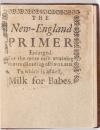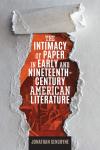AAS draws not only on its traditional resources as a center of bibliographical research and as a matchless repository of early American printed materials, but also on recent intellectual currents that look at the history of books and other printed objects in their full economic, social, and cultural context.
History of the Book
| Colonial Revivals: The Nineteenth-Century Lives of Early American Books | ||
| Revolution and the Word: The Rise of the Novel in America | ||
| Poisonous Muse: The Female Poisoner and the Framing of Popular Authorship in Jacksonian America | ||
| Knowledge Is Power: The Diffusion of Information in Early America, 1700-1865 | ||
| Revolutionary Networks: The Business and Politics of Printing the News, 1763-1789 | ||
| A Fictive People: Antebellum Economic Development and the Reading Public for American Novels, 1837-1857 | ||

|
The New England Primer | In 1995, The American Antiquarian Society acquired one of the two earliest known copies of the New England Primer. Considered a staple text of Puritan childhood that taught letters, reading, and religion, the first edition of the New England Primer was most likely printed between 1683 and 1690, either in London or Boston. Early printings of the text, such as the AAS copy that was printed in 1727, are extremely scarce because of heavy use by generations of children and families. |
| |
Subscription Publishing in America | Led by Michael Winship |

|
Random Notes from a Book History Bureaucrat | Twenty-seventh Annual James Russell Wiggins Lecture in the Program in the History of the Book in American Culture. In this lecture, John B. Hench, retired vice president for collections and programs at AAS, will combine elements of memoir, reflections on the development and influence of the Society's Program in the History of the Book in American Culture (PHBAC), and notes on some of the themes in his recent scholarship on publishing in the World War II era. |

|
The Intimacy of Paper in Early and Nineteenth-Century American Literature | The true scale of paper production in America from 1690 through the end of the nineteenth century was staggering, with a range of parties participating in different ways, from farmers growing flax to textile workers weaving cloth and from housewives saving rags to peddlers collecting them. |